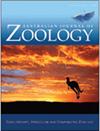新南威尔士南部台地火灾后桉树再生植被的营养质量及其被考拉食用的情况
IF 1
4区 生物学
Q3 ZOOLOGY
引用次数: 0
摘要
澳大利亚东南部的大部分森林和林地都容易发生火灾。这些地貌通常以桉树属树种为主,其中许多树种在火灾后都能熟练地进行外植体再生。包括考拉在内的几种有袋类食叶动物都以桉树叶为生。人们对表生叶的营养成分以及食叶动物能否利用表生叶知之甚少。2019-20特大火灾发生后,我们向考拉提供了新南威尔士州南部台地的8种桉树的表胚叶,并测量了已知会影响考拉摄食的叶片化学成分(总氮和可利用氮、甲酰基氯葡萄糖醇化合物(FPCs)和未取代B环黄酮(UBFs))的浓度。人工饲养的考拉吃了属于亚属 Symphyomyrtus 的四个桉树品种的外果皮叶片,但吃了亚属 Eucalyptus 品种的叶片相对较少。合欢上生叶片中的可利用氮明显高于单萼叶片,而且不同物种之间存在差异。FPCs和UBFs的浓度在桉树物种之间也存在差异。我们的研究结果表明,在新南威尔士州南台地,合叶桉树种的火后上生幼苗可能比单桉树种更容易被考拉啃食。因此,对于考拉来说,一些烧毁地区可能比其他地区的栖息地质量更好。本文章由计算机程序翻译,如有差异,请以英文原文为准。
The nutritional quality of post-fire eucalypt regrowth and its consumption by koalas in the New South Wales Southern Tablelands
Most forests and woodlands of south-eastern Australia are fire prone. These landscapes are typically dominated by tree species of the genus Eucalyptus, and many of these are proficient epicormic resprouters after fire. Several marsupial folivores rely on Eucalyptus foliage, including the koala. Little is known about the nutritional composition of epicormic leaves and whether folivores can utilise them. Following the 2019–20 megafires, we offered koalas epicormic leaves from eight eucalypt species that occur in the New South Wales Southern Tablelands and measured concentrations of foliar chemical constituents known to influence koala feeding (total and available nitrogen, formylated phloroglucinol compounds (FPCs), and unsubstituted B-ring flavanones (UBFs)). Captive koalas ate epicormic leaves from the four eucalypt species belonging to the subgenus Symphyomyrtus but ate relatively little from the species of the subgenus Eucalyptus. Available nitrogen was significantly higher in symphyomyrtle epicormic regrowth than in monocalypts and differed between species. Concentrations of FPCs and UBFs also differed between eucalypt species. Our results suggest that post-fire epicormic regrowth from symphyomyrtle species may be more readily browsed than that of monocalypts by koalas in the NSW Southern Tablelands. Therefore, some burnt areas are likely to be better quality habitat for koalas than others.
求助全文
通过发布文献求助,成功后即可免费获取论文全文。
去求助
来源期刊
CiteScore
2.40
自引率
0.00%
发文量
12
审稿时长
>12 weeks
期刊介绍:
Australian Journal of Zoology is an international journal publishing contributions on evolutionary, molecular and comparative zoology. The journal focuses on Australasian fauna but also includes high-quality research from any region that has broader practical or theoretical relevance or that demonstrates a conceptual advance to any aspect of zoology. Subject areas include, but are not limited to: anatomy, physiology, molecular biology, genetics, reproductive biology, developmental biology, parasitology, morphology, behaviour, ecology, zoogeography, systematics and evolution.
Australian Journal of Zoology is a valuable resource for professional zoologists, research scientists, resource managers, environmental consultants, students and amateurs interested in any aspect of the scientific study of animals.
Australian Journal of Zoology is published with the endorsement of the Commonwealth Scientific and Industrial Research Organisation (CSIRO) and the Australian Academy of Science.

 求助内容:
求助内容: 应助结果提醒方式:
应助结果提醒方式:


